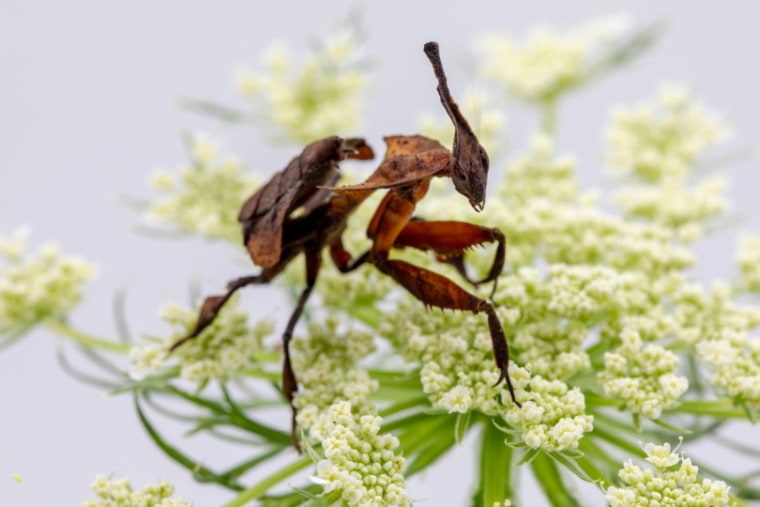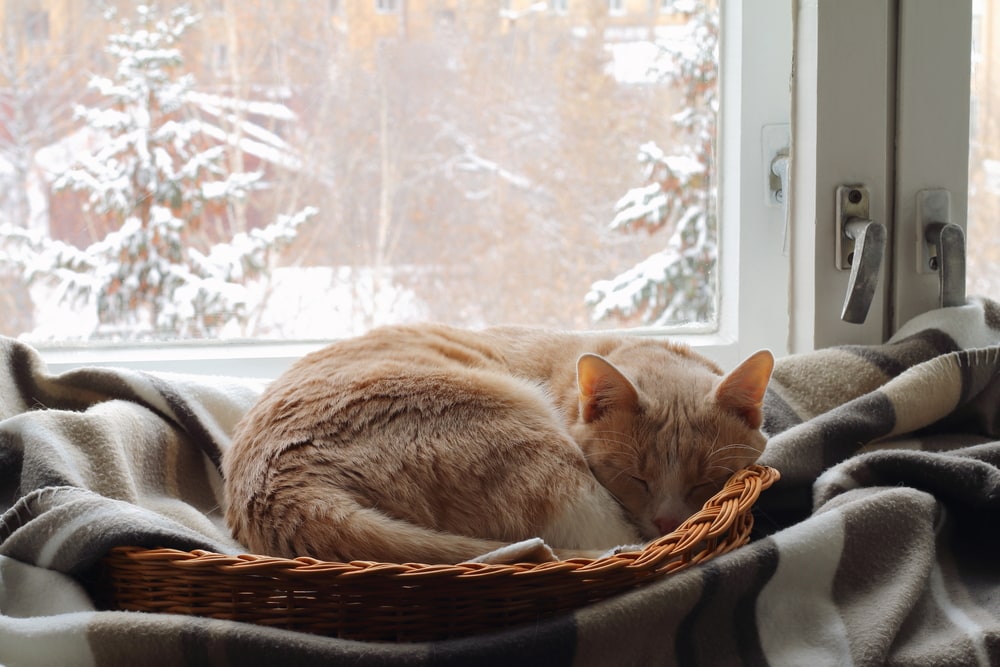
The Ghost Mantis is a small species of Mantis from Africa. It has the unique appearance of a dried and weathered leaf. It’s smaller than the Praying Mantis, and you can usually find them in dry areas with plenty of bushes, shrubs, and trees that will accent its natural camouflage. Keep reading while we look at this interesting species to learn more facts about them to see if they would make a good pet in your home.
 Quick Facts about Ghost Mantis
Quick Facts about Ghost Mantis
| Species Name: | P. paradoxa |
| Family: | Hymenopodidae |
| Care Level: | Moderate |
| Temperature: | 65 – 80 degrees |
| Temperament: | Timid |
| Color Form: | Light brown, dark brown, green |
| Lifespan: | 4 – 8 months |
| Size: | 1.8 – 2 inches |
| Diet: | Houseflies, bottle flies, roaches, crickets |
| Minimum Tank Size: | 1 gallon |
| Tank Set-Up: | Real or fake plants |
Ghost Mantis Overview

The Ghost Mantis is smaller than the Praying Mantis and tends to play dead when threatened, maximizing its camouflage. It molts seven times in its life, and you can actively determine sex after the fourth because females are much more massive despite being the same length. It’s fairly easy to care for, and you can keep a large number of them in a small space as long as there is room for them to move and climb.
How Much Does A Ghost Mantis Cost?
You should expect to pay between $15 and $30 for your Ghost Mantis depending on where you buy it. It’s easy to find them in a pet store, but these will usually be the more expensive ones. Online stores are often less costly, but then you will need to worry about shipping and how they will survive the trip.
Besides the cost of the Ghost Mantis, you will need to purchase a place to house them. You can use an inexpensive netting enclosure or an aquarium, depending on your needs. Aquariums will cost more but will protect your Ghost Mantis better.
Typical Behavior & Temperament
The Ghost Mantis is quite calm and moves very slowly. It’s a communal species that enjoys living in larger colonies, and you can house many of them together with few incidents. When confronted with an enemy, it will typically remain motionless, pretending to be a dead leaf.
Appearance & Varieties

The Ghost Mantis has a leaf-like projection on its head, and there are leaf-like lobes on the legs. The abdomen has a jagged extension on each side that help complete the appearance of a dead leafy branch. Temperature, humidity, and the amount of UV light the Ghost Mantis receives will affect its color, ranging from an almost yellow light brown to a dark brown, and shades of green are also common. The males can even show black and grey colors, especially when they reach sexual maturity.
Molting
Your Ghost Mantis will molt seven times in its life.
After the fourth molt, the female will have much larger leaf appendages than the male, who will have a slender appearance and be a capable flier.
How to Take Care of a Ghost Mantis
Habitat, Tank Conditions & Setup

Your Ghost Mantis is relatively easy to care for and will only require a small area with some real or artificial plants that it can climb on. Many owners prefer artificial plants because if the Mantis places the oothecae, a type of egg sack, it will have a stronger foundation without the fear of the plant rotting or dying.
For a single or a pair of Ghost Mantises, a one-gallon aquarium should be sufficient, and you can put a dozen or more in a ten-gallon tank. You can also use netting if there are no other pets around to create any size environment, and the Mantis won’t work too hard to escape.
Ghost Mantises prefer the temperature to stay between 60 and 80 degrees with a humidity between 40% and 70%, so they will do well without the need for heaters or humidifiers in most American homes.
Do Ghost Mantis Get Along with Other Pets?
The Ghost Mantis can live in a large colony without danger of turning to cannibalism, even though they are carnivorous. However, mixing other species will likely cause infighting, and we don’t recommend trying it., especially since the Ghost Mantis is smaller than many others, like the Praying Mantis.
What to Feed Your Ghost Mantis

The Ghost Mantis typically eats fruit flies, but as they age, their diet can contain various insects, including crickets, bottleflies, moths, roaches, and more. Crickets are the most popular for a captive Mantis colony because they are easy to find in most pet stores and are relatively inexpensive. You can even breed your own.
Keeping Your Ghost Mantis Healthy
Your Ghost Mantis lives between 4 and 8 months, with the female outliving the male by several weeks. They are quite tolerant of temperature and humidity, so as long as you keep it within the guidelines listed above, your pets should see all seven molts, and it will remain healthy.
Breeding
The Ghost Mantis is a prolific species that can begin mating two weeks after adulthood. Place the males in a warming tank with high humidity for several days while ensuring the female is well fed. After a few days, place one or two females in at night, and by morning they should be locked with a male. They can remain locked for up to eight hours. The female will begin laying oothecae shortly after. Oothecae will take about six to ten weeks to begin hatching, and you can expect 20 – 60 nymphs. The female can lay 12 or more oothecae in a lifetime, and they are typically less than a quarter-inch in diameter with a small thread-like extension on one end. Providing cooler temperatures for the female will cause her to lay a longer ootheca instead of several smaller ones
 Are Ghost Mantis Suitable for You?
Are Ghost Mantis Suitable for You?
The Ghost Mantis is a wonderful pet for anyone who enjoys an exotic pet. It can live in a small area and doesn’t have any special temperature or humidity needs, so it’s easy to raise in almost any home in America. They eat very little, so the cost of feeding is minimal, and they breed quickly. If you have at least one male and female, you will likely be raising Ghost Mantis for the foreseeable future. They look amazing, and anyone who visits your home will want to see them.
We hope you have enjoyed reading this guide, and it has helped answer your questions. If we have convinced you to get a few of these for your home, please share this guide to the Ghost Mantis on Facebook and Twitter.
Featured Image Credit: Anthony King Nature, Shutterstock
 Quick Facts about Ghost Mantis
Quick Facts about Ghost Mantis





